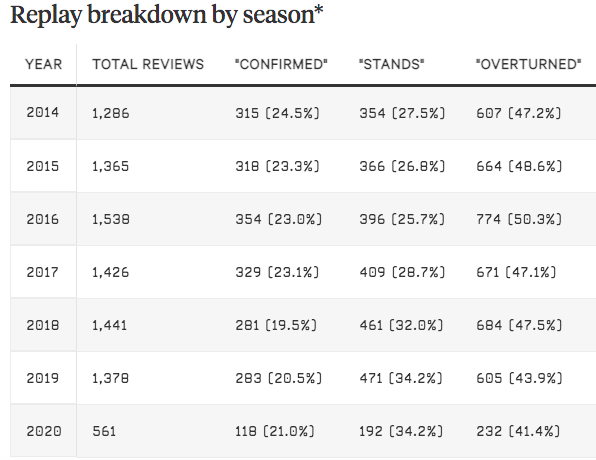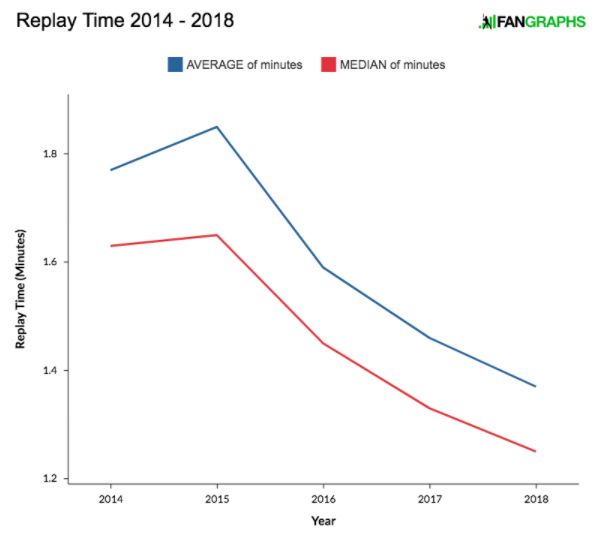Last week, the flaws of Major League Baseball’s replay system were exposed on the national stage. In the top of the 9th inning on Sunday Night Baseball, Alec Bohm tagged up from third base on a shallow fly ball hit by Didi Gregorius. After a few bounces, Marcell Ozuna’s throw reached Travis d’Arnaud, but not before Bohm had beaten the applied tag. Did Bohm touch home plate, though? It’s pretty apparent that he didn’t.
Live Play and Instant Replay Angles (0:39-2:44)
The Braves were rightly outraged at the call. Brian Snitker came out to argue with the umpires after a few expletives and a hat toss. This act most often results in an immediate ejection, but the umpires let Snitker air his grievances and remain in the game. Snitker pointed to the video board a few times. He presumably said that everyone could see that Bohm hadn’t touched home plate. Snitker also inquired as to why the replay officials were the only ones who couldn’t see that Bohm had missed home plate. To find answers to Snitker’s simple questions, you have to first understand the fundamental flaw of MLB’s replay review system.
“Lack of Clear and Convincing Evidence” Clause
MLB’s website reads as follows, “Replay officials review all calls subject to replay review and decide whether to change the call on the field, confirm the call on the field or let stand the call on the field due to the lack of clear and convincing evidence.”
After an official review of the Bohm play, the replay official in New York concluded that “After viewing all relevant angles (we) could not definitively determine that the runner failed to touch home plate prior to the fielder applying the tag. The call STANDS, the runner is safe.”
So, the replay official decided neither to change nor confirm the call. Instead, he decided to let the call stand due to the lack of clear and convincing evidence. Therein lies the flaw in the system. Why does it take clear and convincing evidence to overturn a call that a human made in real time? With the use of state-of-the-art replay technology, why does the call made on the field hold any weight in the final determination? Isn’t the goal of replay to correct the wrong calls made by humans?
The Bohm play is just one of far too many instances where the call on the field stands because of “a lack of clear and convincing evidence”. In replay reviews, what constitutes “clear and convincing evidence”? Is it 100% sure? 75% sure? How can anyone ever watch a replay review and be entirely sure? Allowing the replay official an option that lets them off the hook of making a definitive decision isn’t ideal. In 2020, 34.2% of calls that went to replay stood. This means that in more than a third of replay reviews the final decision given to players, coaches, and fans after using replay is unsatisfying. It doesn’t tell us whether the runner was out or safe. So, we end up waiting a few minutes, using slow-motion replays and synchronized angles all to defer to the call made in real-time. The “lack of clear and convincing evidence” option also allows the replay official to avoid overturning his fellow umpires’ missed call. No umpire wants to be the guy who shows up the umpires on the field constantly by overturning their calls. This undoubtedly leads to fewer calls being called correctly after the use of replay.
There is an easy two-part solution to fix these issues. The first part is to take out the “lack of clear and convincing evidence” clause. This would force the replay official to make a definitive decision about the call on the field. The second part is to make the replay official review the play without knowing the original call made on the field. This would force the replay official to be impartial and to avoid any bias toward his fellow umpires’ call. If you are going to send the decision to replay, it only makes sense to take out any weight from the call made on the field.
The implementation of this two-part solution would undoubtedly lead to both more impartial and correct calls. From 2014-2020, the rate of overturned calls has hovered between 41.4% and 50.3% per season. With almost a third of calls invoking the “lack of clear and convincing evidence” clause, you could reasonably expect the amount of overturned calls to rise somewhere into the 60%-70% range.
It’s not as if the replay monitors employed by the teams are without the same video as the replay officials in New York. Team replay monitors are also given a 30 second period to review the play and make a decision on whether to challenge. In most instances, this is plenty of time to make an informed decision. If armed with a period to review and the same angles as replay officials, why are team replay monitors wrong over half the time? The answer is they’re not. The system they’re trying to figure out just doesn’t make the right call often enough.
Pace of Play
Pace of play isn’t necessarily a glaring problem for fixing the replay system. After all, the time per review has been steadily going down over time.
It is fair to wonder if the replay times MLB reports are entirely accurate. Likely, these times don’t capture the full downtime that results from a replay review.
What we do know is that each review involves:
- a 30 second period for the team to decide whether to challenge
-
the umpires walking to the headset from their positions
-
the waiting period for the call
-
the umpires returning to their spots on the field
-
any warmup pitches taken by the pitcher to stay loose
In 2021, it feels like there has to be a more efficient method for the replay process. Could every umpire stay in their spot with the crew chief receiving a text with the call? Could the crew chief wear an earpiece that he hears the call on? Could the league add another umpire to each crew that could deliver the call? There’s a variety of methods that would delay the game for a shorter period.
According to Sports Illustrated, “MLB began to arrange plans last year for umpires to announce results of replay changes with NFL-style explanations over public address systems, but COVID-19 wiped out those plans. Umpires are on board and the plans are still in place, but COVID-19 protocols still are delaying the rollout. You might see such announcements in time for postseason play this year. If not, it should be a go in 2022.”
While these announcements would certainly offer more clarity, they would only add to the delays for replay reviews. Tacking on additional time to a sport already worried about pace of play issues doesn’t exactly make much sense from an entertainment perspective.
The ultimate goal of a replay should be to provide the correct call while delaying the game for the least possible amount of time. MLB’s replay system might be broken right now, but it’s only a few changes away from being much quicker, effective, and less confusing for everyone involved.
Photo by John Adams/Icon Sportswire | Adapted by Jacob Roy (@jmgraphics3 on IG)


